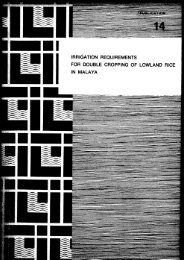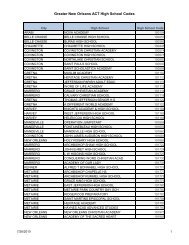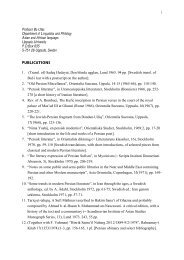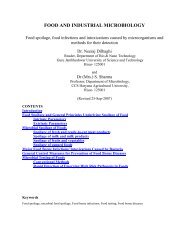On the Future of Indigenous Traditions - Munin
On the Future of Indigenous Traditions - Munin
On the Future of Indigenous Traditions - Munin
Create successful ePaper yourself
Turn your PDF publications into a flip-book with our unique Google optimized e-Paper software.
Finally, it is those groups who have come from outside in <strong>the</strong> recent past dominate<br />
and control <strong>the</strong> bureaucratic machinery <strong>of</strong> <strong>the</strong> state. Even though <strong>the</strong> capital has<br />
moved to Ranchi, <strong>the</strong> same characteristic and culture <strong>of</strong> exploitation persists.<br />
Common talks are such as <strong>the</strong> “dikus –meaning outsiders here referred to Biharis,<br />
Bangalis and o<strong>the</strong>r non-Adivasis, would not give up <strong>the</strong> south <strong>of</strong> Bihar state (now<br />
Jharkhand), which has been <strong>the</strong> dikus ‘milking cow’,” so <strong>the</strong> exploitation continues in<br />
<strong>the</strong> system as long as outsiders control it. Therefore, “dikus would not want <strong>the</strong><br />
original settlers or <strong>the</strong> native people (<strong>the</strong> Adivasis) to rise up to higher social level”.<br />
We find that all ‘<strong>the</strong> tricks <strong>of</strong> <strong>the</strong> book’ are being used to break <strong>the</strong> already weakened<br />
social system <strong>of</strong> <strong>the</strong> Adivasis who have lived here for ages.<br />
At <strong>the</strong> same time when we try to understand <strong>the</strong> situation <strong>of</strong> Adivasis in a given<br />
context, <strong>the</strong>re are questions asked by <strong>the</strong> general category <strong>of</strong> people saying why<br />
should <strong>the</strong>y (Adivasis) be seen as a distinctive group and have special privileges?<br />
Some non-Adivasis would also argue, that by defining <strong>the</strong>m as different (or called, to<br />
be <strong>the</strong> indigenous), <strong>the</strong>y are being encouraged as an ethno-political entity in <strong>the</strong> region<br />
leading to <strong>the</strong> notion <strong>of</strong> fragmentation in <strong>the</strong> national integration.<br />
The former rule <strong>of</strong> Bihar, including <strong>the</strong> culturally different south and now Jharkhand<br />
has more or less <strong>the</strong> same administrative and bureaucratic character even today. The<br />
Adivasi movement in Jharkhand is from a given <strong>the</strong>oretical frame <strong>of</strong> ethnic identity,<br />
national identity according to Prakash, is termed as <strong>the</strong> “sub-national political<br />
movements”. The Jharkhand movement started with <strong>the</strong> Unnati Samaj in 1914 for<br />
“tribal autonomy” and “reformation in terms <strong>of</strong> abandonment traditional customs and<br />
practices and adoption <strong>of</strong> education and new values.” 116 The Adivasi Mahasabha in<br />
1938 “in <strong>the</strong> form <strong>of</strong> a socio-cultural movement began with a certain degree <strong>of</strong><br />
militancy for rejuvenating and revitalizing <strong>the</strong> tribal society” 117 This was headed by<br />
Congress worker Jaipal Singh, which later formed itself to become <strong>the</strong> Jharkhand<br />
Party in 1950 started with two objectives. First was <strong>the</strong> demand for statehood for <strong>the</strong><br />
116 K.L. Sharma, “The Question <strong>of</strong> Identity and Sub-Nationality: A Case <strong>of</strong> Jharkhand Movement in<br />
Bihar”in Jharkhand Movement <strong>Indigenous</strong> peoples’ Struggle for Autonomy in India edited by R. D<br />
Munda and Basu Mallick ( Copenhegen: IWGIA, 2003), 234.<br />
117 Ibid.<br />
76

















